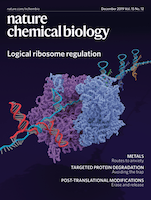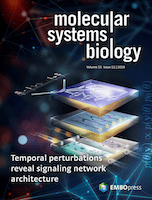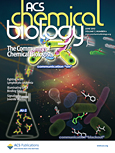
Nature Chemical Biology
Scope & Guideline
Unveiling Molecular Mechanisms for a Brighter Future.
Introduction
Aims and Scopes
- Chemical Biology and Biochemistry:
The journal emphasizes studies that explore the chemical processes within and related to living organisms, including enzyme mechanisms, metabolic pathways, and the chemical basis of biological function. - Synthetic Biology and Genetic Engineering:
Research that involves the design and construction of new biological parts, devices, and systems, as well as the re-design of existing biological systems for useful purposes. - Chemical Probes and Therapeutics:
Papers focusing on the development and application of chemical probes to manipulate biological systems, as well as the design of small molecules for therapeutic applications. - Structural Biology:
The journal publishes work that elucidates the structures of biological macromolecules and complexes, contributing to our understanding of their function and interaction. - Systems Biology:
Integrative studies that combine experimental and computational approaches to understand the complexity of biological systems and their dynamics. - Interdisciplinary Approaches:
Nature Chemical Biology encourages studies that bridge different scientific disciplines, integrating chemistry, biology, physics, and engineering to address challenging biological questions.
Trending and Emerging
- Biomolecular Condensates:
Research on biomolecular condensates has surged, focusing on their roles in cellular organization and function, reflecting a growing interest in understanding phase separation in biological systems. - CRISPR and Genome Editing Technologies:
The journal has seen an increase in papers related to CRISPR technologies, including advancements in gene editing, base editing, and their applications in therapeutic contexts. - Machine Learning and AI in Drug Discovery:
There is a growing trend towards utilizing machine learning and artificial intelligence to enhance drug discovery processes, optimize chemical libraries, and predict biological activity. - Targeted Protein Degradation:
Research on targeted protein degradation techniques, such as PROTACs, has gained momentum, reflecting the interest in developing new therapeutic modalities that harness the cellular degradation machinery. - Sustainable Chemistry and Biocatalysis:
Emerging themes in sustainable chemistry, including the use of biocatalysis and environmentally friendly synthetic methods, are increasingly highlighted as researchers seek greener solutions to chemical problems.
Declining or Waning
- Traditional Medicinal Chemistry:
There has been a noticeable decline in papers focused solely on traditional medicinal chemistry methods, as the field shifts towards more integrated approaches involving chemical biology and systems biology. - Basic Biochemical Pathway Studies:
Research that explores basic biochemical pathways without a clear application or link to broader biological implications is becoming less common, with more emphasis now on translational applications. - Single-Cell Analysis Techniques:
While still relevant, the volume of papers focusing exclusively on single-cell analysis has decreased, possibly due to the rising prominence of more comprehensive systems biology approaches that integrate multiple data types.
Similar Journals

Chemical Biology Letters
Connecting Molecular Discoveries to Clinical ApplicationsChemical Biology Letters is a prominent academic journal dedicated to the evolving field of biochemistry and its applications in medical and clinical contexts. Published by ScienceIn Publications, this journal serves as a vital platform for researchers, professionals, and students alike, showcasing cutting-edge findings and innovations that drive forward our understanding of chemical interactions in biological systems. With its scope ranging from molecular biology to clinical biochemistry, Chemical Biology Letters is committed to advancing knowledge and fostering collaboration within the scientific community. Recognized for its quality, the journal is categorized in Q4 for Biochemistry and Molecular Biology fields, while achieving notably higher ranks in Medical Biochemistry, reflecting its significant contributions to the discipline. Aiming to remain accessible to a diverse audience, the journal is published in open access format, inviting researchers worldwide to explore and share invaluable insights. Established in 2014, it continues to grow in impact and relevance, paving the way for advancements in both theoretical and applied research within the realm of chemical biology.

ACS Central Science
Catalyzing Connections in the Chemical CommunityACS Central Science is a prestigious, peer-reviewed journal published by the American Chemical Society, focusing on innovative research across the diverse landscape of chemistry and chemical engineering. Established in 2015 as an Open Access platform, it has rapidly risen in prominence, achieving a remarkable Q1 ranking in both Chemical Engineering and Chemistry fields, with an impressive Scopus percentile of 98th and 96th respectively. This journal serves as a vital resource for researchers, professionals, and students seeking to disseminate and access cutting-edge advancements in these disciplines. By removing the barriers to access, ACS Central Science promotes the exchange of ideas and fosters collaborative research, ensuring that high-quality, impactful findings are available to all. With its clean and modern online interface, accessible from the heart of Washington, DC, the journal continues to attract leading scholars while influencing the trajectory of chemical sciences well into the future.

Nature Chemistry
Pioneering Research in Chemistry and Engineering.Nature Chemistry is a prestigious journal published by NATURE PORTFOLIO, focusing on groundbreaking research in the realms of chemistry and chemical engineering. Since its inception in 2009, this esteemed publication has garnered significant recognition, currently ranking in the Q1 category for both Chemical Engineering and Chemistry (miscellaneous) as of 2023. With an impactful presence, it ranks 4th out of 273 in General Chemical Engineering and 9th out of 408 in General Chemistry, placing it within the top 2% of journals in its field. Nature Chemistry aims to publish high-quality, peer-reviewed articles that advance our understanding of chemical science and its applications, catering to an audience of researchers, professionals, and students eager to explore innovative discoveries. While it offers various access options, dedicated readers appreciate its contribution to the scientific community from its base in Berlin, Germany.

EGYPTIAN JOURNAL OF CHEMISTRY
Exploring the Intersections of Chemistry and InnovationThe Egyptian Journal of Chemistry, published by the National Information & Documentation Centre (NIDOC), serves as a vital platform for disseminating novel research and advancements in the field of chemistry and its interdisciplinary applications. Established in 2004 and continuing its publication through 2024, this journal encapsulates a diverse range of topics including Biochemistry, Chemical Engineering, and Materials Science, reflected in its respectable Scopus rankings. With an array of Quartile rankings indicating its varying impact across different categories, scholars can benefit from its insights into innovative solutions and methodologies that address pressing scientific challenges. Although it currently does not operate under an open access model, researchers and students are encouraged to leverage its findings as it plays a pivotal role in the academic landscape of Egypt and beyond. For those engaged in chemical research, the Egyptian Journal of Chemistry stands as an essential resource, contributing significantly to the global body of scientific knowledge.

Annual Review of Biochemistry
Your Essential Resource for Biochemical AdvancesAnnual Review of Biochemistry is a premier publication in the field of biochemistry, renowned for its comprehensive and critical reviews that collate significant advancements and insights since its inception in 1946. Published by Annual Reviews in the United States, this journal maintains a prestigious position within the academic community, boasting a Q1 ranking in the biochemistry category for 2023, with an impressive Scopus rank of #4 out of 438, placing it in the top 1% of its field. With a commitment to excellence, it serves as an essential resource for researchers, professionals, and students striving to stay at the forefront of biochemical research. While the journal does not operate on an open-access model, it continues to provide key insights and knowledge that fuel innovation and discovery in the life sciences. As it converges research from various eras up to 2024, Annual Review of Biochemistry remains a vital contributor to the development of molecular biology and genetics, catering to the needs of a diverse readership keen on advancing their understanding and expertise in biochemistry.

Molecular Systems Biology
Advancing the Frontiers of Biological ScienceMolecular Systems Biology, published by SpringerNature, is a premier open access journal that has been a cornerstone in advancing the fields of biological science since its inception in 2005. With its ISSN 1744-4292, this journal exemplifies high scholarly standards, boasting an impressive suite of impact factors, including Q1 rankings across various disciplines such as Agricultural and Biological Sciences, Biochemistry, Genetics and Molecular Biology, and more, highlighting its significant contribution to the scientific community. The journal offers robust access options to facilitate innovative research dissemination, reaching a global audience while maintaining a commitment to fostering collaboration and dialogue among researchers, professionals, and students. With a focus on integrating quantitative approaches to biological systems, Molecular Systems Biology plays a vital role in addressing complex biological questions, paving the way for groundbreaking discoveries and advancements in healthcare, environmental sustainability, and functional genomics.

TRENDS IN BIOCHEMICAL SCIENCES
Connecting Researchers with Cutting-Edge ScienceTRENDS IN BIOCHEMICAL SCIENCES is a premier academic journal published by CELL PRESS, focusing on the latest advancements and insights in the dynamic fields of biochemistry and molecular biology. With an ISSN of 0968-0004 and an E-ISSN of 1362-4326, this journal has established itself as a leading source of high-impact research, boasting an impressive Q1 category ranking in both Biochemistry and Molecular Biology as of 2023. The journal's Scopus Ranks further highlight its significance, placing it in the top 3% and 4% of its respective fields, emphasizing its role as a vital platform for disseminating innovative research. Published since 1976 and continuing through 2024, TRENDS IN BIOCHEMICAL SCIENCES provides a comprehensive overview of the latest trends, methods, and applications, helping researchers, professionals, and students stay at the forefront of their disciplines. Although it offers traditional access options, the journal's rich content and authoritative analysis make it a must-read for those pursuing cutting-edge biochemical research.

International Journal of Biology and Chemistry
Catalyzing Scientific Progress Across Biological and Chemical RealmsInternational Journal of Biology and Chemistry (ISSN: 2218-7979; E-ISSN: 2409-370X) is a distinguished peer-reviewed journal published by AL-FARABI KAZAKH NATIONAL UNIVERSITY, dedicated to advancing the interdisciplinary fields of biology and chemistry. This journal aims to foster a comprehensive understanding of biological systems and chemical processes, thereby promoting collaborative research and innovative methodologies. With a rigorous selection process and commitment to quality, the journal provides a platform for original research articles, reviews, and case studies that contribute to the scientific community's knowledge base. Although specific metrics such as H-Index and Scopus rankings are currently not listed, the journal continues to be an important resource for researchers, professionals, and students alike. By providing open access to high-quality research outputs, the International Journal of Biology and Chemistry is poised to make a significant impact in its field, bridging gaps between biological sciences and chemistry while encouraging groundbreaking discoveries.

ACS Chemical Biology
Advancing the Frontiers of Chemical BiologyACS Chemical Biology is a premier journal published by the American Chemical Society, dedicated to advancing the understanding of the chemical underpinnings of biological systems. With an ISSN of 1554-8929 and a distinguished track record since its inception in 2006, this journal provides a vital platform for the dissemination of high-quality research in the realms of biochemistry and molecular medicine, achieving a prestigious Q1 ranking in these categories as of 2023. In an era where interdisciplinary approaches are crucial, ACS Chemical Biology fosters collaboration among chemists and biologists, reflecting a steadfast commitment to exploring the chemical processes that govern life. Although it does not operate under an open-access model, the journal maintains a rigorous peer-review process, ensuring the publication of influential studies that shape the future of chemical biology. With an increasing impact factor and a focus on innovative research, ACS Chemical Biology remains an authoritative resource for researchers, professionals, and students eager to engage with cutting-edge findings in this dynamic field.

CHINESE JOURNAL OF CHEMISTRY
Shaping the future of chemistry with impactful research.The CHINESE JOURNAL OF CHEMISTRY, published by WILEY-V C H VERLAG GMBH, is a distinguished peer-reviewed journal that has been contributing to the field of chemistry since its inception in 1990. With an impressive Q1 ranking in the Chemistry (miscellaneous) category and a Scopus rank of 67 out of 408, this journal is recognized for its rigorous scholarly standards and significant impact within the academic community. Renowned for publishing high-quality research, reviews, and insightful commentaries, the journal serves as a vital resource for researchers, professionals, and students keen on advancing their understanding of general chemistry and its applications. Although it does not offer open access, the journal remains an essential outlet for innovative chemistry research, attracting contributions from a global network of specialists. With its broad scope covering various aspects of chemistry and a commitment to fostering scientific dialogue, the CHINESE JOURNAL OF CHEMISTRY is poised to continue its role as a central pillar in the ever-evolving landscape of chemical sciences.